Mission control: You need to bend your knees a little more. Keep your head down.
Alan Shepard: I'm... wearing a space suit.
Mission control: Just trying to help.
Apollo 14, the third crew ever to land on the Moon, pulled one of the most iconic stunts of all time.
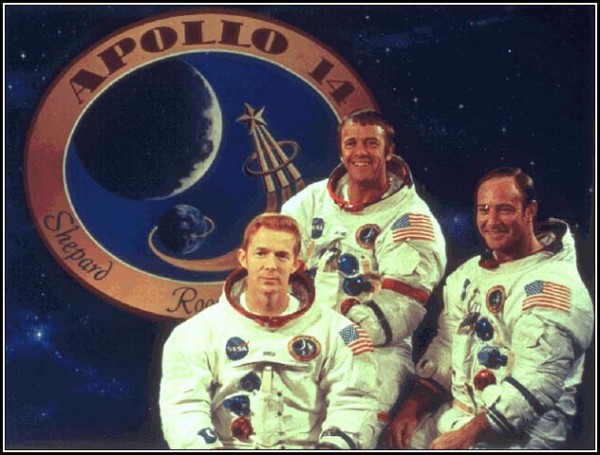
Along with Stuart Roosa (left) and Edgar Mitchel (right), commander Alan Shepard (center) became the first man to golf on another planet.
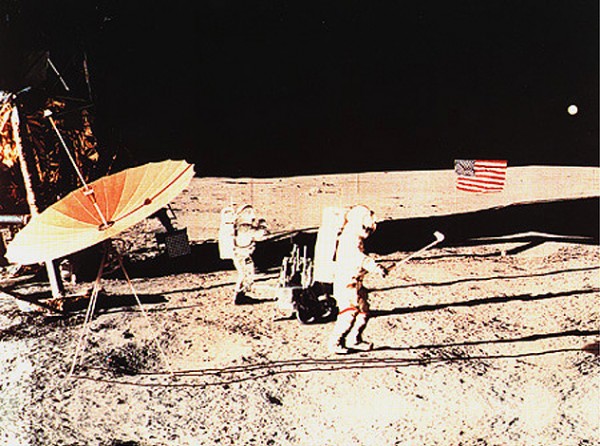
His famous quote, after hitting the ball squarely, was:
Miles and miles and miles.
But take a look at the video itself. It sure doesn't seem like that ball would've gone miles and miles and miles at all.
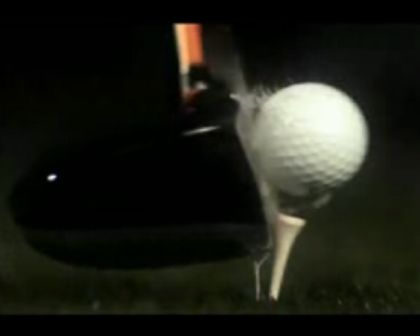
But the Moon's a little different. With no atmosphere (and no air resistance), and only one-sixth of the Earth's gravity, we can figure out -- with a little help from physics -- how far it would be possible to hit a golf ball on the Moon! We need to know two things to figure it out: how fast the ball can move and what angle to hit the ball at.
So what's the fastest initial speed a golf ball can have? Well, you can measure the speed of a golf club without too much problem.
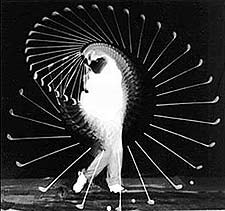
Even a typical amateur golfer can swing a club at 90 miles per hour (40 m/s). Does that mean the ball goes off at that speed? Hardly. You can make the ball go twice that speed! How? Just make sure you've got a club head that's much more massive than the ball, and that you've got an elastic collision, and you're in business!
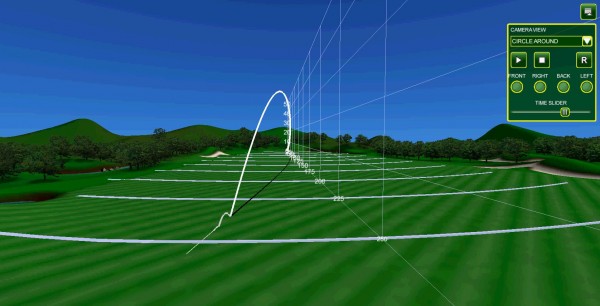
This is very different from Earth, where you hit the ball at a relatively low angle and rely on aerodynamics to minimize wind resistance and maximize the distance. On the Moon, you've simply got to launch it at 45 degrees, and that's the farthest it can go on the fly!
And you want it to go on the fly, because the surface of the Moon is like one giant sand trap. So how far is that?
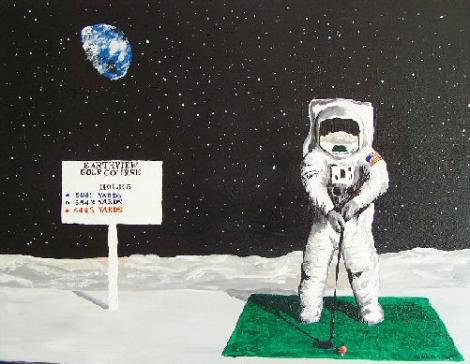
Nearly two and a half miles, or 3948 meters! Not only that, but it would take more than a minute (69.8 seconds) for the ball to come back down! In fact, it's totally conceivable that Alan Shepard's one-armed, 6-iron shot on the Moon holds the record for the farthest golf shot in the history of humanity!
So surprisingly, the answer is yes, miles and miles and miles is totally realistic for a golf shot on the Moon!

Now, if only there were some good way to find that ball in the great sand trap that is the Moon's surface...

Some day, future astroarchaelogists will have massive debates over the findings of weird, dimpled white spheres found on the moon. Some will argue that they are incontrovertible evidence of aliens. Others that they must have been some form of spent fuel nuclei from whatever bizarre hydrocarbon combustion system the ancient Ameicans used to scramble their primitive metal box up there.
Some fringe group will put forward the theory that a civilisation that could barely haul itself around the Earth in less than a couple of days, or explore the bottom of the oceans, went to the moon and played a game of golf.
But no one will take them seriously.
Just give those people having fun with the LRO a little longer.
>Now, if only there were some good way to find that ball in the great sand trap that is the Moon's surface...
Should not be too hard - there already are golf balls that incorporate LED lighting for night play, and even some that "beep", so they can be found in the underbrush.
Replace that with a homing radio signal, and you can open the first golf course on Luna.
http://www.golf-for-business.de/golfportal/golfbaelle-sondermodelle.php (sorry, in German, but there should be some equivalent somewhere on the inet...)
"Tracer" is blinking 7 times a second, "Trakflite" is with sound.
The lack of familiar distance cues might make it hard for a person on the moon to judge the distance that the ball flew, even with an easy-to-spot ball.
Speaking of which, there's probably a lot of UV, so a UV-fluorescing ball should be easier to spot.
No atmosphere on the moon so sound would be out of the question. A little radio beacon might help since radio is electro-magnetic in nature.
Nice.
One quibble:
If it's the Moon, is it really a planet?
Don't you also need to consider whether the moon's low gravity affects how much force you can exert?
I don't mean that I know it does, but I'd like to see the issues this raises. For example, does low gravity make it harder to keep your balance? Are your feet more likely to slip when you try to put a lot of power into your swing?
Never mind gravity, how hard can you actually swing in one of those suits!?
Not to nitpick, but the lede is a tad misleading: Stuart Roosa, as the Apollo 14 Command Module pilot, did not get to land on the Moon, so he could not golf.
On the moon, where's the rough? And is Venus a mulligan?
Also, at distance of 3 km curvature of the Moon is non-negligible. It can give you additional 10-20 meters of flight.
Nah, too lazy to calculate the exact figure.
It just occurred to me that with all the cratersdimplesâ , The Moon is someone's lost golfball. Or at least I hope it's lost; I don't think I want to see a proportionately-sized club swinging towards itâ¦
  â  Some of which really are craters. The MoonGiant's Golfball has been stuck in The Orbit Trap for a long, long time now.
John Morales: Most classify the moon as a minor planet, in the same category as Ceres and Pluto... given the size ratio, Luna and Earth look more like a double planet than a planet and satellite.
We should go back and find the blasted ball!
Since at the moon atmosphere is not .so there is no resistance.And at the atmosphere the weight of the ball is one fifth weight of the at the earth
Using a 6 iron would waste some of the energy by imparting spin, wouldn't it? Seems to me that you'd get maximum distance by using a driver and a very high tee to get a launch angle of 45 degrees with very little spin.
Also, wouldn't the moon's curvature affect (albeit slightly) the ideal launch angle? Of course, it's all moot, as we know that you drive for show, putt for dough.
I wonder if the actual trajectory numbers could be computed from the video frames themselves.
More importantly, since the moon's gravity is 1/6th that of the Earth's, could I apply that same fraction to my score? If so, that might make it worth taking up golf again. Of course, there's still the small problem of getting to the course....
if tiger woods hit the ball then may be there is a chance..........just kidding i don't think its ever gonna happen.
I think the optimization of takeoff angle is much more complicated than 45degrees. Even if we take the uniform flat gravitational field, and flat surface for granted, which maxmizes distance at a given velocity, I doubt you can get as high of a takeoff velocity at 45degrees as you can at say 0degrees. So the efficiency of the elastic impact has to be taken account of. Also I think curvature oribably brings the optimum algle down as well. Then depending upon the direction of travel, lunar rotation will either help or hinder your
distance.......
Just for the record, that's not actual dialogue but stuff made up for the ESPN ad. (Most of the rest is real - if dubbed - though.) Transcript is available here - scroll down to 135:08:17.
If this could be possible on the moon could we do it on Earth? if so, how much force would that take?
What would make the golf ball go farther in the air on the moon than on earth? Would being on the moon increase the gravity level and just make the ball float which makes it hover for miles and miles? Could anyone do this or would you need a special golf master to do it? Would the gravitational force on the moon pull you upwards so you wouldn't be able to stand on the platform to be in the correct position to even hit the ball. You would have to be stationary and be able to actually hit the ball with your suit on, so I don't think this would be possible to hit it miles and miles.
My understanding is that it would be a possible hypothesis. Space has no gravity therefore hitting an object on the moon would be possible for miles and miles.
In June 2010, ScienceBlogs started a blog which was sponsored by PepsiCo and was to be written by their employees.[7][8] This lead to backlash by many of the bloggers on ScienceBlogs who considered this to be an unethical mix of advertising and journalism,ccna and the PepsiCo blog was withdrawn from ScienceBlogs. This affair was informally named "PepsiGate", and many bloggers left, including Rebecca Skloot. Subsequently other bloggers, such as Bora Zivkovic, also left although they did not all attribute their leaving directly to the inclusion of the PepsiCo blog.
I would like to thank you for the efforts you have made in writing this post.
Since Moons radius is roughly 1735km, we can assume the ball would travel 0.23% of the radius. Since for such small values of x, cos(x) is roughly equal 0.999997, the curvature of the moon itself would probably affect the distance by much less than a meter. However, while covering the distance of 4km, the ball would spend most of the flight above the altitude of 500m. And since gravity force is reverse proportionally to the distance from the moons core, the average gravity affecting the ball at 0.5km would be about 0.06% smaller than at the surface. This gives us 0.03% more time in the air (because t = sqrt(2*s/a)), which would gain over a meter in distance :)
Following is the corrected version of my post:
Since Moons radius is roughly 1735km, we can assume the ball would travel 0.23% of the radius. Since for such small values of x, cos(x) is roughly equal 0.999997, the curvature of the moon itself would probably affect the distance by much less than a meter. However, while covering the distance of 4km, the ball would spend most of the flight above the altitude of 500m. And since gravity force is reverse proportionally to the square distance from the moons core, the average gravity affecting the ball at 0.5km would be about 0.06% smaller than at the surface. This gives us 0.06% more time in the air, which would gain over 2 meters in distance :)
So a Golf ball will go a long way, but would it be possible to put something off with such force that it will orbit the moon like the moon orbits earth?
Like if you shoot a rifle at the right angle will the bullets continue to orbit the moon?
Lonman, if the bullet has too much kinetic energy, the orbit will be so elliptical that part of that orbit will be under the moon's surface. So the bullet wouldn't manage one complete orbit, nor escape.
Apollo moon landings are faked it is clear.
If you are going to hit a ball upward at a 45 degree angle it has be on a tee. This ball was dropped in the dust. The only way to get elevation is to hit "down" on it to produce backspin - the dimples on the golf ball interact with the air and this makes the ball rise. No air - no backspin - no altitude - no "miles and miles". Complete baloney.
I've seen golf clubs. They have angled heads.
Oh, and please wait until All Hallows before resurrecting the dead.
tks.
Wow. You must know a lot about golf. Gee. I didn't know they had angled heads. I never took that into consideration. I thought they were all flat faced. You're a genius. It doesn't matter. The moon is made of fine sand. Have you ever seen a pro get out of a sand trap? He has to blast it out to get under it. Watch someday.
No, Hugh. You must know nothing about golf.
Gee.
I didn't know that someone so lacking in knowledge of golf would make strident proclamations about it.
But you did.
Oh, the moon isn't made from sand.
Oh, and have you ever seen a pro get out of a moon dune? No? Then Whiskey Tango Foxtrot.
Hey buddy - you can't hit a ball "up" on the moon without a tee. And even with that - it would hardly go up. Take some time to study the evolution of the golf ball before embarrassing yourself in public.
Yes you can Hugh. Someone did. See the flaming article. And please explain what about the evolution of the golf ball indicates that you're NOT full of crap?
Apparently you don't know enough to shut the fuck up when you're making a fool of yourself.
PS did you ever consider how that golf ball gets into the sand trap? Ever seen someone place a ball on the surface of a sand trap and bury it in the sand before teeing off?
Is this going to be another case of some internet retard going "full retard" and thinking "Hey, maybe I can get Wow banned!".
If you're fucking about, take it to the dump thread:
http://scienceblogs.com/startswithabang/2012/09/23/weekend-diversion-yo…
If you can't restrain yourself, read this from Ethan first:
http://scienceblogs.com/startswithabang/2016/01/02/comments-of-the-week…
which says the same frigging thing I did.
A No.9 iron has a 'loft' of 41 degrees, hence the approximate takeoff angle will be around that, depending on the user, stance, how deep the ball is in the local terrain,etc. A pitching wedge has a loft of 45 degrees. The same principles apply to lofting the ball on Luna without the hindrance of an atmosphere. Since there is less gravity, greater distance is achieved. The pimpling of the ball has no bearing in this scenario - no air, no interaction. The ball WILL take off at that angle with the iron under it, H.B. I don't think you would use a tee to shoot out of a sand trap, would you ?
:)
However being smaller than the earth, the moons horizon is closer at only 2.43km away.
This means the gold ball would go over the horizon and you wouldn't be able to see it land.
And it gets worse. Suppose you made a golf hole that was par 3. That means a pro player should be able to get to the green in one shot. From where you hit the ball, the flag would have to be 6.9km tall for you to just see it peek above the horizon!!!
Golf on the moon would SUCK!!!
Source for solving the quadratic for h:-
https://supernovacondensate.net/2012/09/19/how-far-can-you-see/
So would the grass .....
Whoops. Its been pointed out I forgot the divide by 2. DOH.
So the flag would be 3.5km tall. It still sucks.
And regarding the last comment on the grass, you could use astroturf...... (I know I know, groan).
Heh, heh, heh .....
So do we know if Astronaut Shepard hit a Titleist?